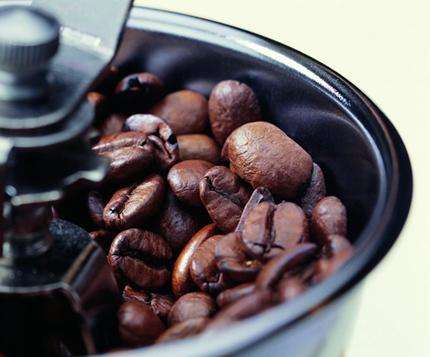Introduction to the Cup Review of Antigua Coffee
Follow the caf é (Wechat official account vdailycom) and found that Beautiful Cafe opened a small shop of its own.
Cup reviews of Antigua coffee:
Aroma 7.8; flavor 7.85; acidity 7.95; balance 7.63; overall 7.78; alcohol 7.85; aftertaste 7.60
Delicate, well-balanced, with rich aromas and excellent sweetness.
The Antigua Valley (Antigua Valley) is the oldest and best-known coffee producing area in Guatemala. Volcanoes and extremely shallow groundwater levels form a dry microclimate, characterized by low humidity, adequate sunshine and cool nights.
Antigua is a closed valley surrounded by three volcanoes: Agua, Acatenango and Fuego. Antigua is flat and slightly sloping, unlike other coffee producers located in volcanic areas.
Most coffee trees are planted in the hinterland of the valley, but even so, they have reached an altitude of 5000 feet; in addition, some farmers grow coffee on the slopes of volcanoes, nearly 5600 feet above sea level.

The extremely high content of pumice (pumice) in the soil of Antigua (from the active Fuaigo volcano Fuego) keeps the humidity stable at 65% all the year round, which is very different from other volcanic coffee producing areas, where the humidity usually varies greatly between the dry and wet seasons.
Fertile volcanic soil, low humidity, plenty of sunshine and cool nights all make Antigua unique.
The three majestic volcanoes Agua, Acatenango and Fuego surround the Antigua Valley. Every once in a while, Fuego-- one of Guatemala's three active volcanoes adds fresh, mineral-rich ash to the soil of Antigua. The volcanic pumice in the soil can keep the soil moist, greatly making up for the lack of precipitation in Antigua, which is the least rainy of the eight coffee-producing regions in Guatemala.
Like all Guatemalan boutique coffee, Antigua coffee is grown in shade. In Antigua, shade is mainly used to protect coffee trees from frost, which is cold and sometimes frosty from December to February every year. Dense shade and extremely shallow aquifers work together to create a unique micro-climate for the coffee trees living in it.
The National Coffee Association of Guatemala (ANACAFE) is roughly divided into eight producing areas according to the conditions of coffee flavor, climate, soil and altitude.
Location of eight major producing areas
Microclimate in eight major producing areas
Andigua producing area / average temperature 18 ℃-22 ℃
Fertile volcanic soil, low humidity, sufficient sunshine and cool evening breeze are the characteristics of this area. The area is surrounded by three volcanoes. Whenever the Fuego volcano erupts, the mineral-rich ash mixes with the soil to make up for the lack of rainfall and gives the coffee a special smoky aroma.
Coffee flavor: sweet and sour balance, unique cocoa aroma. It is generally mentioned that the standard acidity of Guatemala is based on this area.
Traditional Attland producing area / average temperature 20 ℃-23 ℃
In this area, among the three major volcanic producing areas of the country, the soil is the most rich in organic matter. 90% of the coffee plants are planted along extremely steep volcanic slopes, and the daily cool breeze from the Atitl á n lake gives the region's microclimate its own style and characteristics.
Coffee flavor: strong flavor, with intoxicating aroma, sweet in sour taste.
Koban rainforest producing area / average temperature 15 ℃-20 ℃
The year-round cloud, abundant rainfall and cool climate are mainly divided into rainy season and rainy season in this area. At the same time, affected by the tropical climate of the Atlantic basin, the cultivated soil is mostly limestone and clay.
Coffee flavor: the characteristics are very different from other producing areas, with bright and subtle sour taste, there is also a light wine aroma.
New Oriental producing area / average temperature 18 ℃-25 ℃
Rain Water is abundant in this area, and the climate is similar to that of Koban rainforest. Because it is located in the resting volcanic zone, the soil contains a lot of metamorphic rocks and minerals, which is very different from other areas with frequent volcanic activity.
Coffee flavor: contains aroma, obvious acidity and good texture. This area is the newest coffee producing area in Guatemala.
San Marcos volcano / mean temperature 21 ℃-27 ℃
The warmest coffee producing area in Guatemala has abundant rainfall, the densest rainy season and the earliest flowering period. Because of the unexpected rainfall during the harvest season, most growers dry coffee beans in the sun first and then by machine.
Coffee flavor: bright sour fruit, full bean body, with fresh, light floral aroma.
Akatilanda Valley producing area / average temperature 14 ℃-31 ℃
The coffee in this area grows at 2000 meters, and the rough, sandy soil is rich in minerals because of the Fuego volcano nearby. Caressed by the mild sea breeze of the Atlantic Ocean and significant climate differences, coffee beans are more suitable for sun-drying.
Coffee flavor: the sweetness is good, the fruit acidity is delicate, and the flavor and aroma are loved by most people.
Weiwei plateau producing area / average temperature 20 ℃-24 ℃
Among the three non-volcanic producing areas, this area is the driest and highest-lying area in the single coffee producing area. It is also the most rugged and remote part of Guatemala, where coffee can be grown at nearly 6500 feet because of the dry, hot wind from Mexico and frost-free mountains.
Coffee flavor: bright and delicate acidity, with a slight wine aroma.
Farrakhan Nice Plain / average temperature 12 ℃-26 ℃
The volcano in this area is high above sea level and the soil is rich in pumice. Farrakhan Nice Plain is still an active volcanic area, so that the coffee in this area is similar to Antigua.
However, Rain Water's abundant, high and varied humidity, and large temperature difference give the Farrakhan Nice Plain a very different flavor.
Coffee flavor: elegant aroma, mild and mellow overall texture, with special and pleasant acidity.
What is the first thing that comes to mind when you think of Guatemalan coffee? Is this the name of the ancient capital, the god of flowers? This is the name of a brand, and the meticulous smoky taste is correct. This is the characteristic of Guatemalan coffee. The main factor is caused by volcanic geology. Coffee has saved the Guatemalan economy in the past 100 years. It is estimated that there are about 120000 thousand local producers, which are the main export items.
Huasen is produced by Las Pastores, a well-known local processing plant in Guatemala, and its quality is strictly supervised by the well-known La Minita Raminita Group. These delicate and complicated procedures are all to ensure that the best quality Huashen coffee is provided by the Pastores processing plant.
Antigua is the most famous of the eight major producing areas in Guatemala. The unique volcanic soil shade planting makes the coffee beans in Antigua have a unique and detailed smoky flavor, which is loved by Taiwanese.
Property Characteristics: farm characteristics
Farm farm name: Las Pastores belongs to the manor
City City: Sacatep é quez
Region producing area: Antigua Antigua
Country country: Guatemala
Grade level: S.H.B
Altitude altitude: 1600 Murray 1750 meters
Soil soil: Red Volcanic Loam soils volcanic clay
Harvesting Method:Hand picked is harvested by hand
Coffee Characteristics: coffee characteristics
Variety varieties: bourbon, Caturra, Typica
Processing System treatment: Fully washed washing method
Appearance appearance: .17-18 mesh
Top Jury Descriptions judge's comment: the baking degree measured by the cup for 60 seconds at the beginning of the first explosion (Cinnamon)
Aroma aroma / flavor flavor: vanilla, nuts, chocolate, hazelnut, caramel, brown sugar, cream
Acid quality: grape, plum, citrus, malic acid
Complex complexity and other other: tropical fruit pineapple mango style, oil ester smooth feel good, caramel sweet, a little smoky finish
Cup test experience: high acidity, high emulsification, silky texture
Cup test date: June 23, 2015 Cup test score: 87
Vivette South Fruit Coffee Bean Huehuetenango
Origin: Guatemala
Production area: Huehuetenango
The way in the place of raw beans: washing
Baking degree: medium baking degree
Flavor: medium taste, refreshing, fruity, slightly sour.
Important Notice :
前街咖啡 FrontStreet Coffee has moved to new addredd:
FrontStreet Coffee Address: 315,Donghua East Road,GuangZhou
Tel:020 38364473
- Prev

Comparison of Yunnan small Grain Coffee Arabica Variety Yunnan Iron pickup and Katim
Follow the caf é (Wechat official account vdailycom) and found that different varieties of coffee beans have different taste stimuli when opening a small shop of its own. Want to know the past life of Arabica coffee beans. Today, the editor leads us to pick the best and most expensive coffee beans in the world.
- Next

Introduction of Antigua coffee beans with smooth taste
Following Cafe (official Wechat account vdailycom) found that Cafe Beautiful opened a small shop of its own. Coffee was really introduced to Guatemala in 1750, introduced by Father Jesuit, and the coffee industry was developed by German colonists at the end of the 19th century. Today, most of the coffee industry's production takes place in the south of the country. There are seven major coffee producing areas in Guatemala
Related
- Detailed explanation of Jadeite planting Land in Panamanian Jadeite Manor introduction to the grading system of Jadeite competitive bidding, Red bid, Green bid and Rose Summer
- Story of Coffee planting in Brenka region of Costa Rica Stonehenge Manor anaerobic heavy honey treatment of flavor mouth
- What's on the barrel of Blue Mountain Coffee beans?
- Can American coffee also pull flowers? How to use hot American style to pull out a good-looking pattern?
- Can you make a cold extract with coffee beans? What is the right proportion for cold-extracted coffee formula?
- Indonesian PWN Gold Mandrine Coffee Origin Features Flavor How to Chong? Mandolin coffee is American.
- A brief introduction to the flavor characteristics of Brazilian yellow bourbon coffee beans
- What is the effect of different water quality on the flavor of cold-extracted coffee? What kind of water is best for brewing coffee?
- Why do you think of Rose Summer whenever you mention Panamanian coffee?
- Introduction to the characteristics of authentic blue mountain coffee bean producing areas? What is the CIB Coffee Authority in Jamaica?

